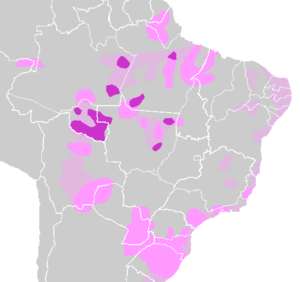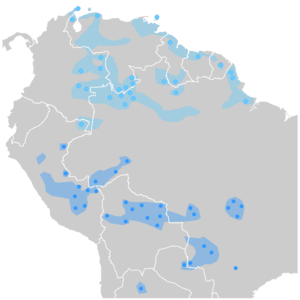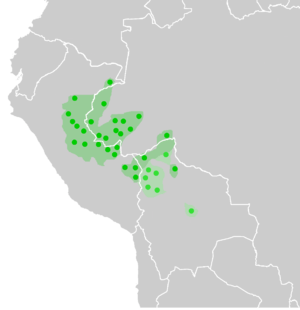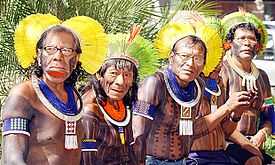Amazonian languages

Amazonian languages is the term used to refer to the indigenous languages of the Amazon. They are a heterogeneous group of languages that belong to separate families and do not have a phylogenetic similarity. Nevertheless, there are certain typological features in common, due to continuous contact between the different families. Because of this some authors propose to speak of the amazon linguistic area.[1]
Introduction


From a cultural perspective the Amazonian rainforest is one of the most diverse linguistic regions of the planet.[2] In the Amazon Basin 300 languages were spoken at the end of the 20th century. The indigenous villages that speak these languages belong to separate language families. There are around 20 distinct families, and a clear phylogenetic relation has not been proven, suggesting cultural as much as linguistic diversity that goes back millennia. This diversity was maintained, in part, due to the fact that the Amazonian regions never had organized societies or empires that lasted long enough to have a mitigating effect in regards to culture and language. The large language families of the region are:
- Tupi languages: the widest family of indigenous languages spoken in the region today, even though part of its expansion in the region happened recently.
- ye or gê languages: among the Tupi languages, this is the widest-spoken language in the Amazonian region.
- Cariban languages: a family that probably expanded from the northern part of the Amazon, although members of this language family exist in the middle of the Amazon.
- Arawakan languages: a family basically circling the Amazonian region.
- Pano-Tacanan languages: Southwest Amazon
- Tucanoan languages: in the higher regions of the amazon and higher Vaupés.
Besides these phylogenetic linguistic groups, there are a number of important small language families that have not been categorized in relation to these and therefore are considered independent groups.
Multilingualism was (and is) the norm among Amazonian Indians.
== History of the Amazonian villages ==

The majority of the Amazon Basin and the Orinoco are the lowlands of a tropical rainforest, rich in edible vegetables and animals. Archeologists estimate that this territory has been populated for less than 12,000 years. The entire population of the area would have arrived only a couple millennia ago. The principal source of protein is fish, supplemented by hunting pecaris, tapirs, rodents and monkeys. The domestication of plants, at first concentrated in the bitter yuca root, dates back 5,000 years. Agricultural expansion, with its version of slash and burn cultivation, began in the mountainsides of the western Andes and was brought to the majority of the main rivers in the Amazon. The villages based on hunting and gathering were pushed to the more inaccessible areas.
Each linguistic group tends to share certain characteristics relative to the type of territory they occupy, the mode of production and the type of cultural materialism. For example, practically all the ethnic groups of the Arawakan, Cariban, and Tupi families occupy areas of tropical rainforest, extensively use agriculture and make canoes, hammocks, and ceramics. On the other hand, the Yê ethnic groups usually live in grasslands, have little agriculture and do not make canoes, hammocks, or ceramics. Nevertheless, they have a more complex social organization. Scattered among the farming villages, in the heart of the jungle, live hunter-gatherers that belong to minor language families, such as the Nadahup, Pirahã and Guajiboan families, more or less the direct descendents of the first hunter-gatherers.
Some groups, especially the agriculturally based ones, have been particularly aggressive and are prone to attack their neighbours. Nevertheless, symbiotic relations exist between different groups: for example the Tucanoans, who are agricultural based, trade with the Nadahup, who are hunter-gatherers. The latter provide animal meat from the jungle and poison obtained from fish, and in exchange receive yuca grain from the Tucanoan plantations, as well as ceramics. Even so, the Nadahup are considered "inferior" by the Tucanoans and are not considered in inter-ethic marriage as the Tucanoans do with other ethnic groups.
The Europeans invaded the region in the 16th century, quickly taking control of the coastal areas and the main rivers as far as they were navigable. The indigenous population began to drastically diminish around 1900; it is estimated that the population was only a 10th of what it had been in 1500 (estimated at between 2 and 5 million).[3] The majority of this loss of life was involuntary, due to European diseases the native Amazonian population didn't have immunity to. The Europeans also used the native Amazonians as slaves. There are testimonies of the Europeans navigating upriver from the mouth of the Amazon, capturing entire tribes and carrying them downriver to the plantations where they worked under difficult conditions, dying in a few years.[4] The Europeans, due to their superior weapons, were able to take whatever piece of land they wanted. Previously the incursions of the colonists were motivated by the possession of resources like rubber or certain minerals, that frequently were preceded by violent actions against the indigenous Amazonians.